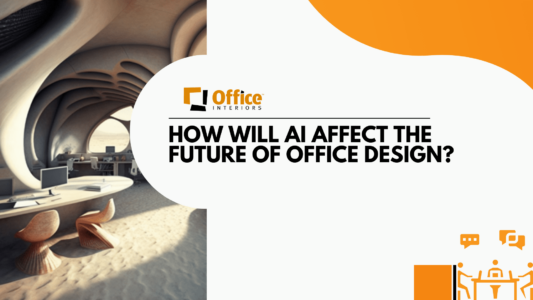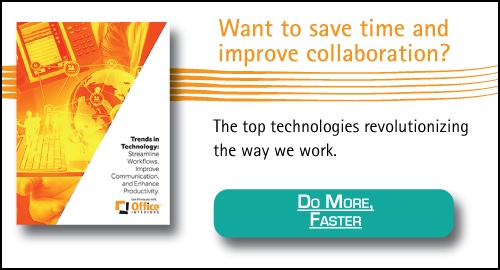As technology continues to evolve and transform our lives, it also significantly impacts how we work. Offices were once endless rows of desks and cubicles, and now they’ve transformed into a central hub where employees can come to work when they’re not at home. Tech-driven work areas, collaboration zones and flexible spaces are all standard design features that come as a part of the modern office. With artificial intelligence (AI) becoming more intelligent and being introduced more regularly into our everyday operations, our work environments can continue to look entirely different once again.
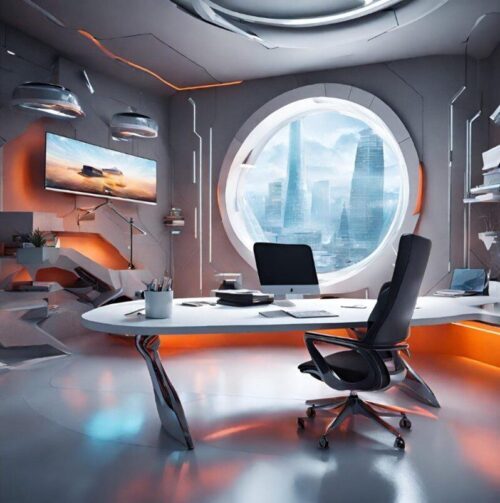
This image was generated by AI.
Anticipating the Future: AI in Office Design
- Understanding Your Team Better with AI
Employee wellbeing is now a primary focus when it comes to office design and with the integration of artificial intelligence, companies will be able to create a more personalized working environment for their team.
Though employers are on the right track when it comes to designing office spaces that cater to their employee’s working styles and preferences, it can still be difficult to understand the needs of every individual, with just traditional ways of gathering information, such as surveys and interviews.
However, through artificial intelligence and analytics, future employers will be able to quickly gather data unique to individual employees, including their behaviours, working styles and preferences. In turn, this will help businesses provide a more accurate view of how the office is currently being used and help them make informed decisions on optimizing their office space further.
- Enhancing Employee Experience through AI
Offices today incorporate diverse work settings, allowing employees to choose the most suitable environment for their tasks and potentially increasing their preference for the workplace over remote work. Great amenities such as café areas and wellness rooms and incorporating elements that evoke a sense of comfort also help companies make their office space more compelling.
As AI gradually becomes mainstream in office design, employee satisfaction will improve. Workplace apps will give staff the power to manage their office space from their mobile device before arriving at the office – adjusting room temperature, scheduling meetings, and managing workplace events will all be a part of this transformation.
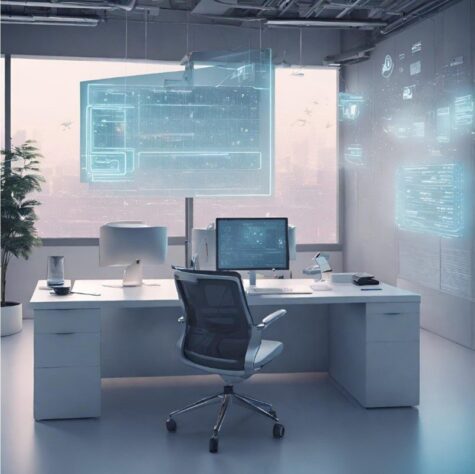
This image was generated by AI.
This control will allow employees to create a working environment catered to their exact needs, allowing them to focus more on meeting deadlines and achieving their long-term goals.
- Improving Physical and Mental Wellbeing
Height-adjustable desks are already great examples of how modern office furniture facilitates an improved office environment for employees. However, as AI becomes more prevalent in the working world, it will merge with these office tools to monitor the health and well-being of staff and encourage healthy habits, such as allotting sitting and standing times throughout the day.
Just like physical health, artificial intelligence is also expected to improve the mental well-being of team members. Bio-sensory technology is continuously improving, and offices will soon be able to monitor employee’s moods and energy levels.
Because this data will be readily available to employers, they can apply it to their future workplace strategies when looking to improve employee motivation and stress levels and optimize productivity levels.
Envisioning a Day in an AI-Enhanced Office
Stepping into the future office, team members are greeted by an advanced AI assistant. AI recognizes faces, providing personalized messages with schedule overviews, weather updates, and relevant news.
The workday commences with a prioritized list of tasks and meetings generated by an AI assistant. It considers deadlines and understands peak productivity times, ensuring high-priority tasks align with these periods. The AI system schedules breaks at optimal intervals, preventing fatigue and maintaining mental well-being.
Meeting rooms in this AI-enhanced office dynamically adjust to the meeting’s nature and participants, regulating lighting, temperature, and noise levels. AI-powered virtual whiteboards facilitate seamless collaboration, capturing and transcribing discussions, assigning action items, and translating conversations in real-time.
In this futuristic office space, AI takes the lead in ensuring physical well-being. Sit-stand desks and ergonomic chairs self-adjust, and AI monitors posture, reminding individuals to adjust for optimal comfort. Guided wellness breaks with stress-relief exercises contribute to a holistic approach to employee wellbeing.
AI also revolutionizes learning and development in the workplace, offering personalized programs based on an employee’s current skill level, learning style, and career ambitions.
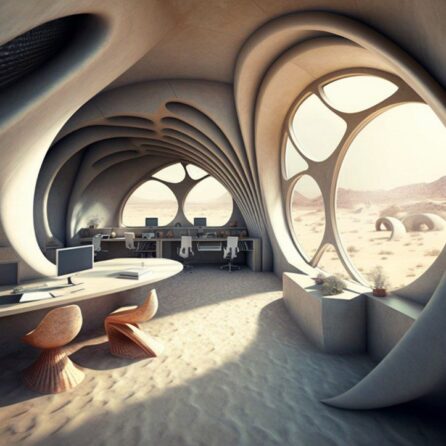
This image was generated by AI.
Does Your Office Need Artificial Intelligence?
While the benefits of AI in terms of automation, decision-making enhancement, and resource optimization are undeniable, businesses must carefully consider the impact on office culture. Though still a few years away, the discussed design features bring forth a new era in workplace innovation. In a time where human interaction is emphasized more than ever, the question then arises: Does your office need artificial intelligence?
Yes, AI can help you to understand your employees’ working patterns and how they navigate the office, and it can also let them set up their desk space before walking through the office door. However, AI doesn’t understand why your team members like to work in specific ways and takes away the need for a morning office chat that we all enjoy.
So, if you’re considering implementing AI into your office design, it’s essential to consider whether you need it and what impact it could have on your office culture in the long run.
Is AI already a part of your office environment? If so, how is it being incorporated, and what specific aspects have caught your interest? Reach out and share your insights with us. We’d love to hear what you think.
Ahona Saha
Marketing Assistant
Office Interiors


